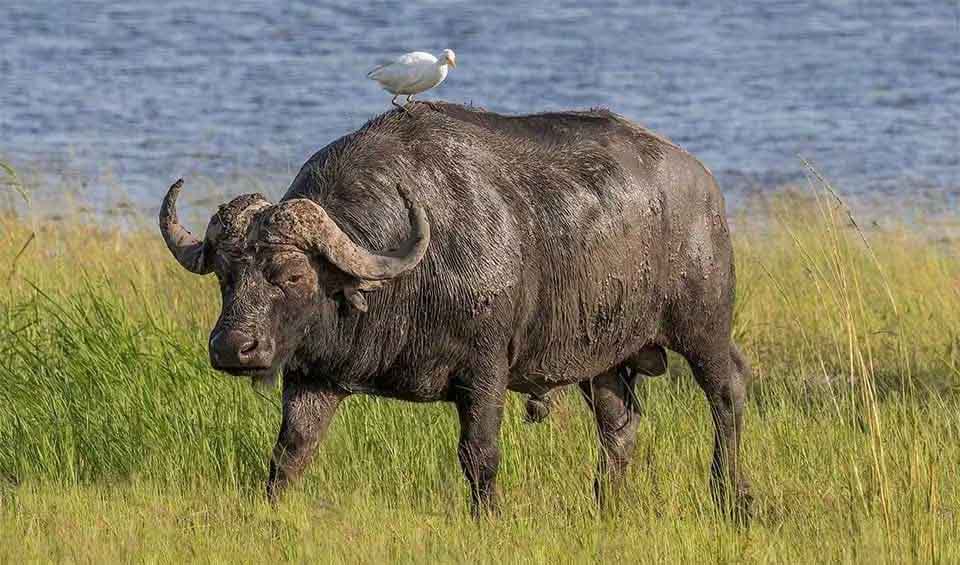A formidable and resilient herbivore native to various parts of sub-Saharan Africa, African buffaloes are characterized by their robust build and striking horn structure. As grazers, they play a significant role in the continent’s ecosystems, influencing the diversity and distribution of vegetation. Despite their herbivorous diet, African buffaloes are renowned for their aggressive nature and strength, making them one of Africa’s most dangerous animals, especially when threatened or injured.
African buffaloes are large, with adults reaching lengths of up to 3.4 meters (11 feet) and weighing 900 kilograms (about 2,000 pounds). Their long, stocky bodies are covered in dark brown or black coats, with older individuals sometimes appearing more grayish. One of the most distinguishing features of the African buffalo is its horns. These horns have a unique growth pattern; they diverge downwards at the base, then curve upwards and outwards. In males, the horns’ bases grow close enough to form a continuous bone shield known as a “boss,” used in battles for dominance within the herd and defense against predators.
The African buffalo is revered and feared for its formidable defense strategies. When faced with predators such as lions, buffaloes can become aggressive and have been known to kill lions or chase them into trees. This collective defense mechanism, especially when protecting calves or injured members, underscores the buffalo’s reputation for solidarity and strength in the face of threats.
Regarded as one of the “Big Five” game animals in Africa, alongside the lion, leopard, rhinoceros, and elephant, trophy hunters often seek the African buffalo. The term “Big Five” was originally coined to denote the five most difficult and dangerous animals to hunt on foot in Africa. While this label has contributed to the African buffalo’s fame, it has also made them a target for hunting, which, combined with habitat loss and diseases such as bovine tuberculosis, poses significant challenges to their populations.
Distribution
 Angola
Angola Benin
Benin Botswana
Botswana Burkina Faso
Burkina Faso Burundi
Burundi Cameroon
Cameroon Central Af. Rep.
Central Af. Rep. Chad
Chad Congo-Brazzaville
Congo-Brazzaville Côte D’ivoire
Côte D’ivoire DR Congo (Kinshasa)
DR Congo (Kinshasa) Equatorial Guinea
Equatorial Guinea Eritrea
Eritrea Official estimate
Official estimate
 Eswatini
Eswatini Ethiopia
Ethiopia Gabon
Gabon Gambia
Gambia Official estimate
Official estimate
 Ghana
Ghana Guinea-Bissau
Guinea-Bissau Guinea
Guinea Kenya
Kenya Lesotho
Lesotho Official estimate
Official estimate
 Liberia
Liberia Malawi
Malawi Mali
Mali Mozambique
Mozambique Namibia
Namibia Niger
Niger Nigeria
Nigeria Rwanda
Rwanda Senegal
Senegal Sierra Leone
Sierra Leone Somalia
Somalia South Africa
South Africa South Sudan
South Sudan Sudan
Sudan Tanzania
Tanzania Togo
Togo Uganda
Uganda Zambia
Zambia Zimbabwe
ZimbabweAnything we've missed?
Help us improve this page by suggesting edits. Glory never dies!
Suggest an editGet to know me
Terrestrial / Aquatic
Altricial / Precocial
Polygamous / Monogamous
Dimorphic (size) / Monomorphic
Active: Diurnal / Nocturnal
Social behavior: Solitary / Pack / Herd
Diet: Carnivore / Herbivore / Omnivore / Piscivorous / Insectivore
Migratory: Yes / No
Domesticated: Yes / No
Dangerous: Yes / No
African buffalo on banknotes


This is called “inflation”, by the way.






